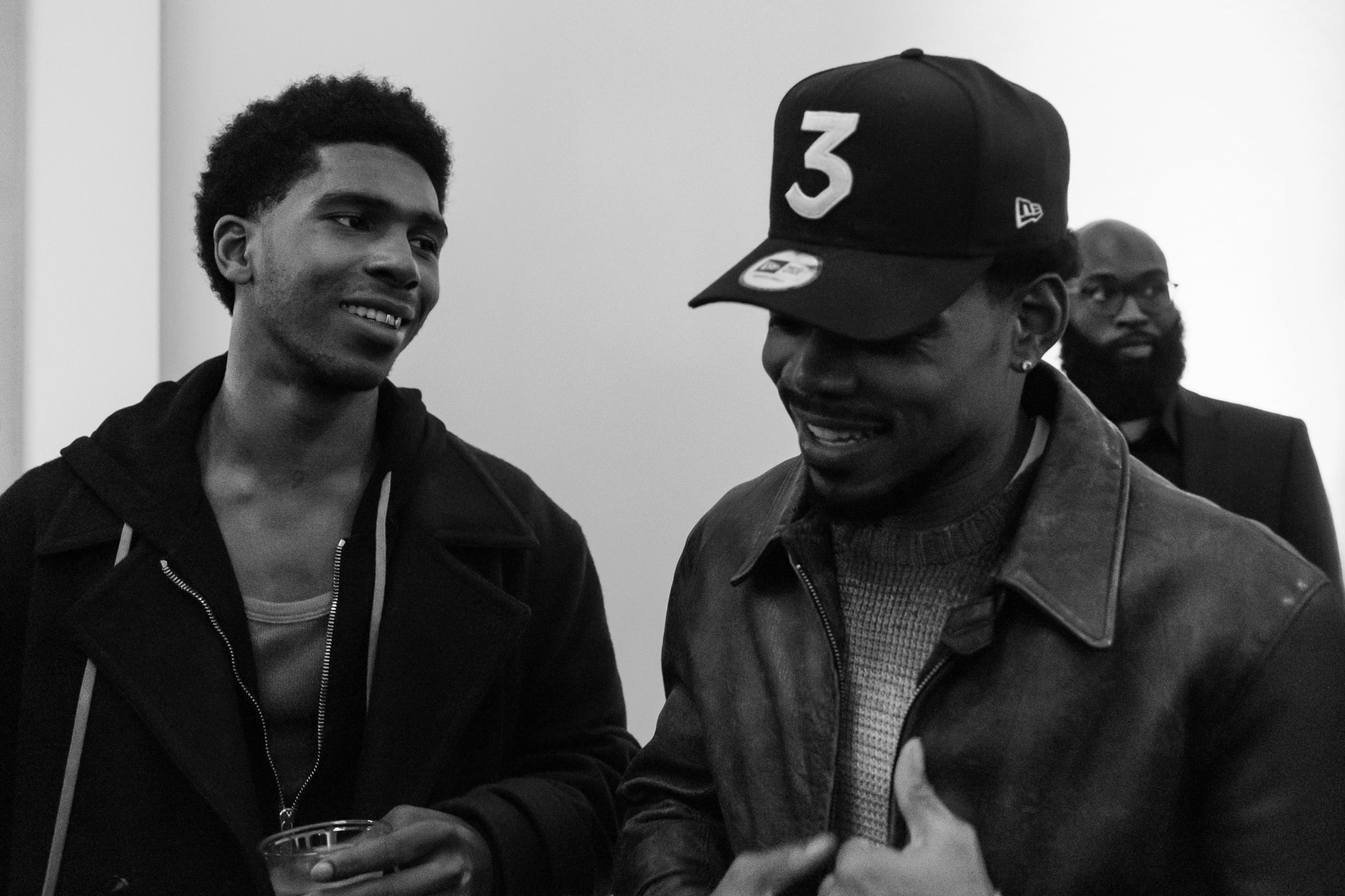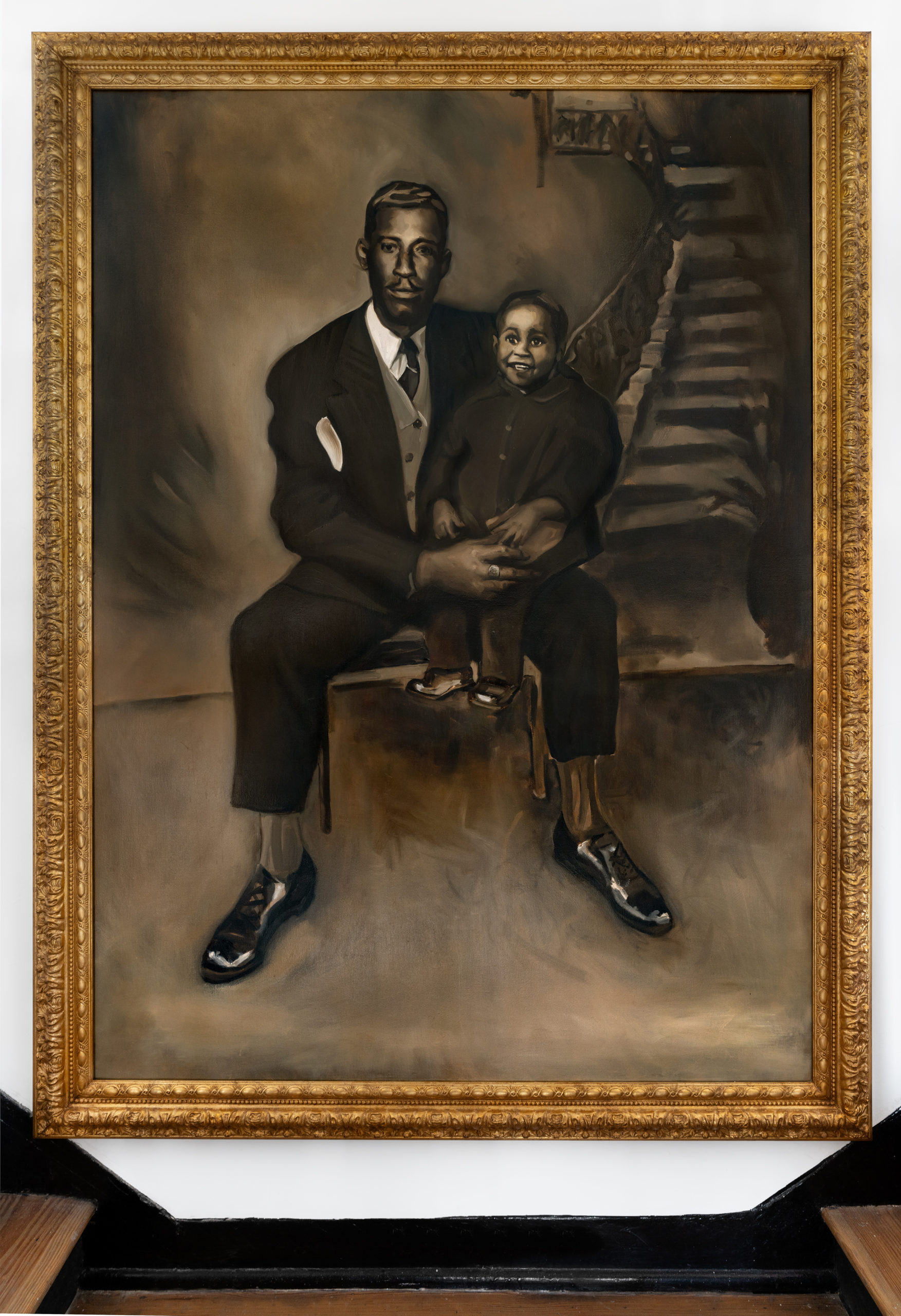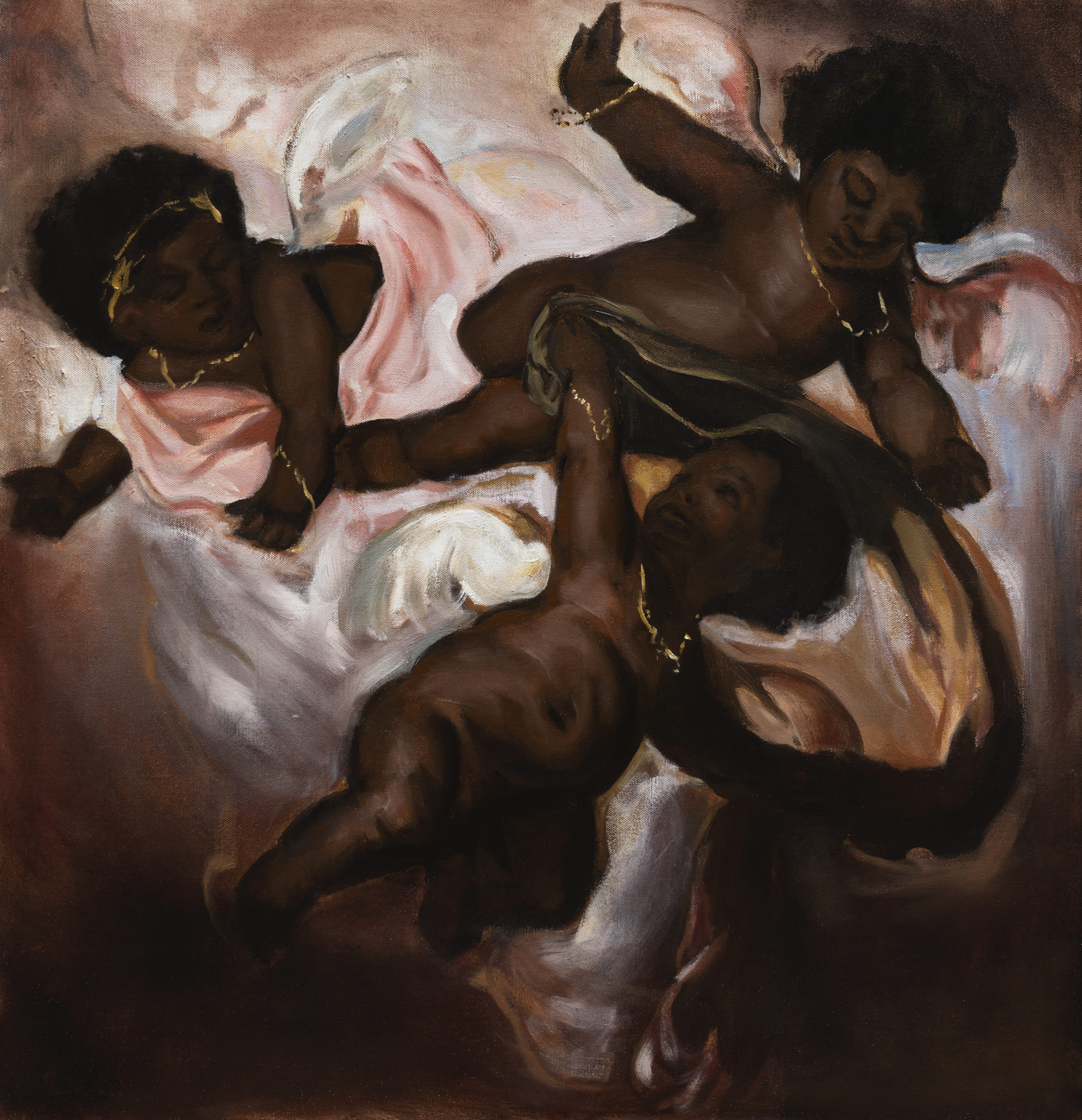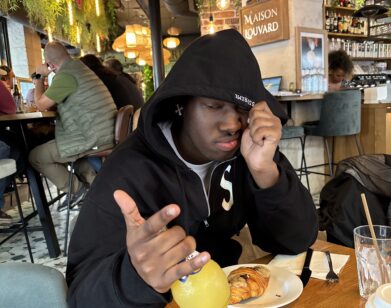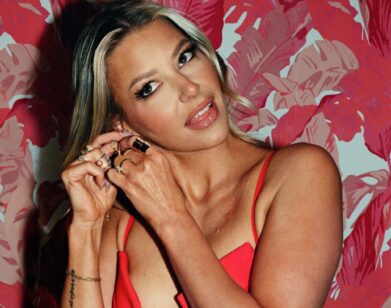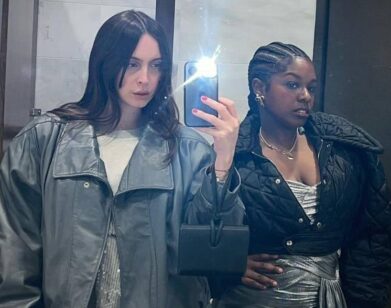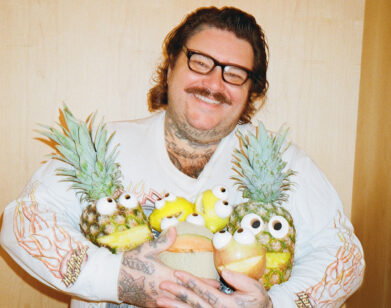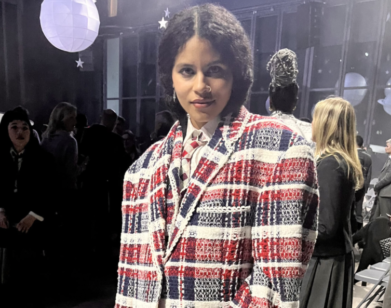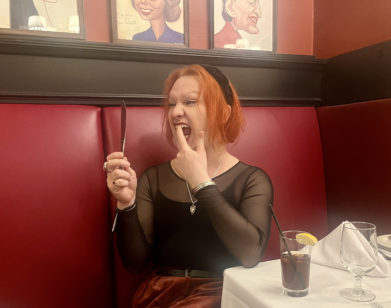IN CONVERSATION
Thelonious Stokes and Chance the Rapper Bring the South Side to Ghana
Before they were established artists paving the way for a new era of Black representation, Thelonious Stokes and Chance the Rapper grew up together on the South Side of Chicago with a mutual love of music and art. To this day, they are collaborators and friends, having recently gone on adventures together in Ghana, where Chance hosted the inaugural edition of the music and art festival Black Star Line in Accra, and Italy, where they took over the Venice Biennale. “You’re making art that makes me want to be an artist because you do it at such a high level,” Chance tells his friend, who did the cover art for his upcoming single “The Last Stare.” Their long-standing relationship is “a testament to how Chicago works,” he adds. Before the opening last month of Stokes’s debut solo show To The Last Page at UTA Artist Space in Atlanta, the two got on the phone to talk about artistic independence, their early days in Chicago, Chappelle’s Show, Emmett and Louis Till, and what Stokes calls the practice of “Blackwashing” in his paintings.
———
CHANCE THE RAPPER: My dog. Can you hear me?
THELONIOUS STOKES: Yo, yo.
CHANCE: What up, foo? You in Italy?
STOKES: Yeah, I’m in Florence right now. I’m finna go to Atlanta tomorrow.
CHANCE: Does the show open tomorrow or do you start getting ready tomorrow?
STOKES: Yeah, it opens on the 27th. This is with UTA, my first show.
CHANCE: Do you remember the title that you told me when we were in Florence? It was like thirteen words. It was raw as hell.
STOKES: Oh yeah, I do bro. “Loaded Activated; Remembering New Religion; The Body of Thelonious Stokes.” That’s like the first shit I had.
CHANCE: That shit goes hard. When did you first start doing these beautiful impressionist pieces? They are obviously inspired by religious texts, but it’s very intentionally Black.
STOKES: That’s a fire ass question, bro. Basically, I used to be into fashion a little bit more than I am now. And I feel like when motherfuckers are into fashion, excuse my French, we always want to find something new. You even put me on with a couple fashion vibes when we were shorties in Chicago, you know what I’m saying? Digging so deep into fashion, I discovered painting and I was like, yo, this is the most fire, newest, freshest way to express myself. That just led me into going into the museum every day, the Art Institute Chicago, and then being like, “Yo, I have to move to Italy if I really want to open up this technology of oil painting.” And then in Italy, there’s a whole bunch of religious imagery everywhere, on every corner. So I was able to pull from that. As soon as I left school, I told myself I was going to paint Jesus off the rip and I did. That kind of leads us to the show that’s going to open.
CHANCE: I noticed that you’ll paint biblical figures that aren’t always Jesus, but the ones that are of Jesus have always been controversial. Now they’ll concede and say Jesus wasn’t white, he was Middle Eastern. So he still wasn’t Black.
STOKES: I feel like that’s still indirectly related to the agenda of saying Jesus wasn’t Black.
CHANCE: I think one of the deepest pieces that you have is A Post Mortem Portrait of Emmett and Louis Till (2021). I got to see it in person. Can you talk about the piece?
STOKES: Everybody knows Emmett Till’s story. We should also know about his father Louis Till, a soldier from Chicago stationed in Italy during World War II. When Emmett Till was around two, Louis Till was actually accused of the murder of an Italian woman and was lynched in Italy not too far from the region in which I live. This is a story that nobody ever told me. Being in this environment, being from Chicago, knowing so much about Emmett Till, this young Black kid who got essentially tortured for a simple gesture, it’s insane to me that I hadn’t heard his father’s story. So I found images of him and I decided to produce a painting of a young Emmett Till sitting on Louis Till’s lap. I was able to bridge that gap from Italy to Chicago. I felt it was my responsibility to share that with the world in a piece of artwork, you get me?
CHANCE: One of the main things people know is that Emmett Till’s body was identified by a ring that was on his finger because he was so mutilated that he couldn’t be identified. It had been floating in the Tallahatchie River for a day or two before they found him, his body was bloated up. This is, again, a thirteen or fourteen-year-old boy. And there’s no pictures of the two of them together, right? Because his father moved to Italy.
STOKES: Exactly. He passed away when Emmett was three.
CHANCE: That’s why it’s so deep to me. You created a unity between a father and son that were both unjustly murdered.
STOKES: Louis Till was murdered by the US government. So he was murdered by the state. Emmett by apparent self-enforcing civilians in the South.
CHANCE: When you put them together in a painting and give them a space where they get to be together, that acknowledges both the criminal aspect of their murders, but also gives them the humanity of life, of showing them living and smiling together. You’re basically correcting a wrong from history and creating community through it after the fact. And I feel like that’s very similar to what you’re doing with the historical Black retellings of the old Italian impressionist works. Giving Mary identity in her Blackness, in her Africanness, is righting an ancient wrong. I think you know, but I want to just make sure that you understand the weight of these pieces that you create.
STOKES: Absolutely. I remember a moment when we were both in Chicago and I told you how we have this consistent term throughout history in relation to how the Egyptian empires are depicted as these tanned-out white dudes. We say the term “whitewash,” they “whitewashed” it. So I feel as if a key element of my practice is the term “Blackwash.” I’m Blackwashing, running it back and reclaiming some of these moments to the point where this can potentially be a climactic shift in contemporary art, religious work, in how we’ve viewed some of these images.
CHANCE: Yeah. I think now that you’ve put it in that context, it’s making me realize it’s so many ways that you do that. I think all art that you look at is going to affect people differently, whether it’s portraiture or abstraction. IAs you continue to do your historical research and divulge that information with other artists and eventually your audience, you’re doing a bit of liberation work because you’re creating a community with that information.
STOKES: Every piece of art that has been produced, for me as an artist, can be considered an apotheosis. We can see full-fledged African influence, full-fledged westernized Christian influence, the future of figuration. How I’m binding religious imagery with political imagery and just really bending these moments could really be a moment to influence future artists. You came out to Ghana for the festival, showing various individuals in Accra a couple of my works. They were like, “Whoa, we need to see that.” To the point where now I want to put my foot in the continent and showcase these images on a larger scale so people can identify with their faith more easily.
CHANCE: What’s crazy is my earliest memory of you is when we used to be in the basement at my house. I remember we used to be teaching y’all dancing. And then I also remember one of my first mixtapes ever, which is called Good Enough. You and my little brother are on the cover modeling, looking like a younger me and Justin [Cunningham, the rapper’s childhood friend]. You remember that?
STOKES: I do remember that, bro.
CHANCE: With the green skinny jeans on.
STOKES: 79th Street.
CHANCE: Bro, we was on the ninth looking crazy. But I think it’s so deep that we were older than y’all, influencing or inspiring y’all, and now you guys are at a point where you guys influence and inspire me. You’re making art that makes me want to be an artist because you do it at such a high level. And we’re finally collaborating in a meaningful way. It’s a testament to how Chicago works. We have these long-standing relationships and communities that get built and now it’s turning into something in our adulthood that’s fruitful.
STOKES: Something that really inspired me is how you changed a lot of the rules when it comes to the music industry. I remember when we were shorties listening to Soulja Boy and all of these artists were backed by really big companies. And that’s one of the reasons why we were exposed to them. Chief Keef is another good example. And you were one of the ones that rewrote the rules, which is something I want to do in the painting realm. Even now, you going to Accra and doing a whole free music festival and that being abundantly successful. That’s something that you’re not supposed to be able to do.
CHANCE: Well, I was saying the other day, a big part of my influence in not wanting to be under a label or work in the industry in a conventional way is something I learned from Dave Chappelle. When I was younger, my dad used to have us watching Chappelle’s Show. We had to watch the Inside the Actors Studio interview with Dave Chappelle before we watched the show. This was his first interview after he was blackballed by the industry. It made me wary of the industry, but on top of that, it made me see the way that he stood tall in that interview. It made me realize that I could do shit my way and stand on my word. When it came time for me to do a record deal in 2012 around the time that “10 Day” came out and [Chief] Keef had just started blowing up and all the labels were flying out to Chicago to meet with all the rappers, I saw that my voice wasn’t going to be respected. I felt like I was capable of being a rapper without having to be signed. I think the problem in all industries is that conglomerates or large scale entities, whether it be a gallery or a music label, can hire artists and basically control their works. They will not only do so in any case that they can, they’ll also try and destroy or marginalize people that refuse the system. What do you think about galleries and collectors and dealers, the people that are strictly on the business side of art? How do you navigate it.
STOKES: Well, from experience so far, I’ve been working out of the studio, grinding, making big ass beautiful oil paintings and that’s been funding everything when it comes to my filmmaking practice, when it comes to ceramics and jewelry and things of that nature. I’ve got to pay the rent, so I have to sell paintings. At this point, since I am independent, I produce and oil this fully functioning machine myself. My grandma always told me that self-preservation is the first law of nature. So I’m always going to continue to move like that. And my father always told me, “Good dope sells itself.”
CHANCE: “Good dope sells itself” is the hardest shit that I ever heard!
STOKES: Yeah. And my dad taught me that.
CHANCE: I think it’s also important that we talk about the piece that we collaborated on. It’s not out yet, but we did “The Last Stare,” which is still, at this point, my favorite overall piece. The intersection of arts is a strong focus of this project and how these things work together from a Black lens, whether it be somebody that’s from Gabon or from Chicago or from D.C. Wherever these artists are from, they’re Black, they have a specific experience, and us working together through our different mediums and producing multi-layered art is always the goal and the outcome. You come from a family with an artistic background and you’re also a multidisciplinary artist. So I wanted to ask you, given that you do sing, you do rap, you do paint, you do sculpt, you do film—how do those different influences and abilities interact with each other and affect the paintings that you do?
STOKES: There’ve been moments where I’ve said, “Oh shit, I’m a singing painter.” These moments just go hand in hand. Even as I’m painting, laying down peach notes, colder notes, bluer notes, a fucking zygomatic bone, they all go hand in hand. We just all recently released a kind of experimental film titled Painter in a Cage where, for the most part, it’s not that much dialogue, but there’s a lot of movement. I’m interacting with the space, I’m interacting with paintbrushes, I completely wrote, edited and directed this work. So it’s a lot of elements in my mind, just bleeding out. Sometimes I notice my girlfriend holding my hand and she’s like, “Oh my god, baby, you’re so warm.” I just say, “Yeah, babe. I got the passion of Christ in me.” Ultimately it’s god’s harp and I’m just a couple fingers that have been blessed to be there. Chicago, bro. We love everything. We over there foot-working, we rapping, somebody taking a picture of it. Somebody going crazy. Chicago filmmakers changed the whole music video game by just shaking the camera a certain way.
CHANCE: Literally.
STOKES: It’s really that deep. There would be no reason for Thelonious to be alive without these beautiful elements of creativity that we’ve been blessed with. And thinking about Africa, man. Africa is a place where people are playing sports and singing and painting all on the same street. On the south side of Chicago, it’s basically like Africa.
CHANCE: Straight up. I’ve been saying that it’s a lot like Atlanta. I call it the A because when you go to Accra, the feeling that you get is that there’s such a communal aspect to economics that isn’t really based on greed as much as it is on hard work and making sure everyone’s accounted for. It reminds me of how you go to a club in Atlanta, before you leave, you not only tip the waitress, but you’ll tip a bartender or a security guard or the parking person. And there’s an understanding that we’re all working together to keep this business working.
STOKES: We’re the security guards in God’s club.
CHANCE: For real. I was going to actually say Italy changed both of our lives dramatically. I can’t speak to all the ways it changed you, but for me, that was the first time that I had traveled to be a part of an art experience. To have my first time be for something as prestigious as the Venice Biennale, it’s a humbling experience. But it also gassed me up in terms of understanding our place in all these different art sectors, seeing that we may have the influence in terms of being the reason why everybody’s coming out and seeing each pavilion, but we don’t necessarily have the power. People that look like us are still stuck outside of the bar or the party or don’t get the right wristbands or are overlooked or mistreated or harassed by the police. People weren’t able to get into some of the pavilion parties. And so we waited around, we got pizza around the corner, and we came back, we saw the bartender or the bar owner and asked him if we could rent out the space for a private party. And we ended up throwing a party that was solely for the artists that were in attendance at the Biennale. And the amount of connections that I made, so many genius artists that I’ve reconnected with since, that was awesome. Afroscope was there. Obviously, the Thelonious Stokes was there.
STOKES: Ayana Jackson, I made great friends with her.
CHANCE: Yeah, Ayana Jackson was there. 200 of us filling out into the streets. Things don’t necessarily just come to us, typically. We have to go out and build and find our own ways. And I think that’s a beautiful thing because in life that’s usually how shit works. Things only work out when you’re intentional about them. What blessed me the most out of everything that I saw was how the community remained intact after the party. I’m still in communication with all the people that we started the Black Venice Alliance with. And I think that’s just what we need. That’s a small preview of what it would look like if we always created spaces for ourselves as artists, as Black folks, as marginalized people. If we can just get together and break bread, we’re much closer. It was definitely one of the best trips I’ve ever taken.
STOKES: Yeah, bro, it was an amazing moment living in Italy. It’s Europe, right? I’m a fucking Black painter from Chicago. There’s not a lot of us. So being with my homies from Chicago in Italy, that level of community was very, very essential, even for my development as an artist. That trip was life-changing for me, too. Being in Venice, being on a boat at fucking 6:30 in the morning after that crazy ass party looking at the sunrise and this Venetian architecture headed back to the hotel. Those are moments that you just cannot make up. And even fast forward to being in Ghana, having a similar situation, being at the beach at 8:30 in the morning and drinking an orange soda looking at the landscape. This is extraordinary. This community is moving continent to continent, city to city, country to country, in unison.
CHANCE: Straight up.
STOKES: Shit, man.
CHANCE: I feel like that was just a raw ass conversation. We dropped so much knowledge.
STOKES: It’s kind of like a healing moment. I always say dialogues and conversations change people’s lives.
CHANCE: Straight up. I’m going to try and come see you in Atlanta. When does the show open?
STOKES: The opening is the 27th, so that’s Friday.
CHANCE: Yeah, maybe I’ll slide through. Love you, man.
STOKES: Peace.

